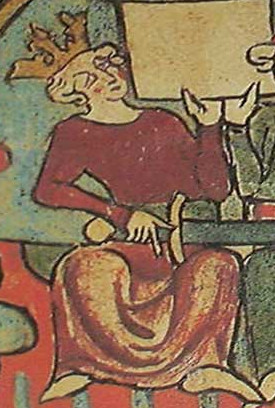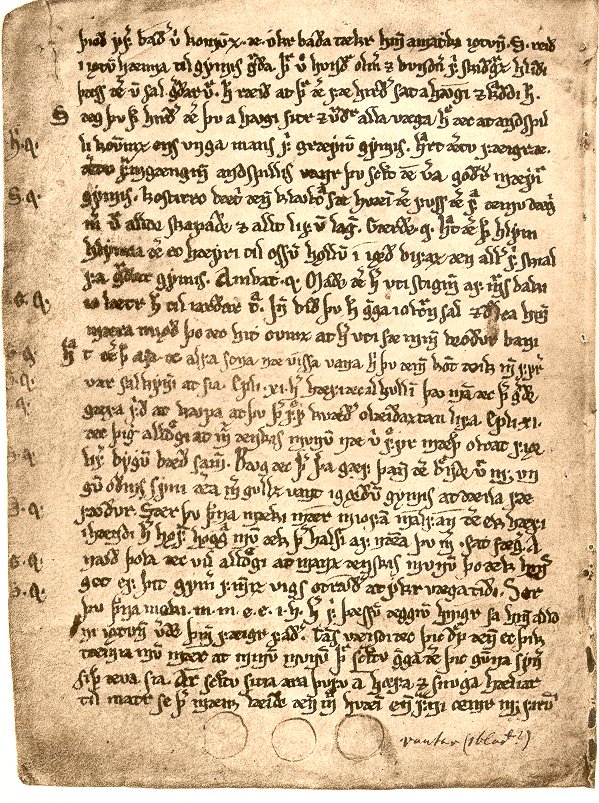|
Kirialax Saga
''Kirjalax saga'' ('the saga of Kirjalax'), also ''Kirialax saga'' is a medieval Icelandic romance saga. It is noted for the array of scholarly sources its author(s) brought to bear. Synopsis Kalinke and Mitchell summarise the saga thus: The saga relates in a leisurely, highly rhetorical manner the fortunes of Laicus, King of Athena, and his son Kirialax. Laicus woos and, through combat, wins the hand of Mathidia, daughter of King Dagnus of Syria. After having reached maturity, their son Kirialax sets out to explore the world of his day. The account of his adventures is an extended travelogue—based on learned sources—that includes a visit to Troja and a pilgrimage to Akrsborg to see the True Cross. At the conclusion of his travels, Kirialax marries Florencia, daughter of King Lotharius of Grikkland. He is crowned king of Grikkland and the seven kingdoms subordinate to it. Two sons, Vallterus and Villifer, are born to the royal couple; they emulate father and grandfather. Man ... [...More Info...] [...Related Items...] OR: [Wikipedia] [Google] [Baidu] |
Romance Saga
The ''riddarasögur'' (literally 'sagas of knights', also known in English as 'chivalric sagas', 'romance-sagas', 'knights' sagas', 'sagas of chivalry') are Norse prose sagas of the romance genre. Starting in the thirteenth century with Norse translations of French '' chansons de geste'' and Latin romances and histories, the genre expanded in Iceland to indigenous creations in a similar style. While the ''riddarasögur'' were widely read in Iceland for many centuries they have traditionally been regarded as popular literature inferior in artistic quality to the Icelanders' sagas and other indigenous genres. Receiving little attention from scholars of Old Norse literature, many remain untranslated. The production of chivalric sagas in Scandinavia was focused on Norway in the thirteenth century and then Iceland in the fourteenth. Vernacular Danish and Swedish romances came to prominence rather later and were generally in verse; the most famous of these are the Eufemiavisorna, the ... [...More Info...] [...Related Items...] OR: [Wikipedia] [Google] [Baidu] |
Arnamagnæan Institute
The Arnamagnæan Institute ( da, Den Arnamagnæanske Samling, formerly ''Det Arnamagnæanske Institut'') is a teaching and research institute established in 1956 to further the study of the manuscripts in the Arnamagnæan Manuscript Collection, the collection bequeathed by the Icelandic scholar and antiquarian Árni Magnússon to the University of Copenhagen in 1730. History and function On 1 July 2003 the Arnamagnæan Institute joined with the institutes for Danish dialectology ( da, Institut for Dialektforskning) and onomastics ( da, Institut for Navneforskning) to form The Department of Scandinavian Research ( da, Nordisk Forskningsinstitut), part of the University of Copenhagen Faculty of Humanities. In September 2017, the Department of Scandinavian Research was merged with the Department of Nordic Studies and Linguistics ( da, Institut for Nordiske Studier og Sprogvidenskab). ''The Arnamagnæan Commission'' ( da, Den Arnamagnæanske Kommission), created in 1772, is the admin ... [...More Info...] [...Related Items...] OR: [Wikipedia] [Google] [Baidu] |
Royal Library, Copenhagen
The Royal Library ( da, Det Kongelige Bibliotek) in Copenhagen is the national library of Denmark and the university library of the University of Copenhagen. It is among the largest libraries in the world and the largest in the Nordic countries. In 2017, it merged with the State and University Library in Aarhus to form a combined national library. The combined library organisation (the separate library locations in Copenhagen and Aarhus are maintained) is known as the Royal Danish Library ( da, Det Kgl. Bibliotek). It contains numerous historical treasures, and a copy of all works printed in Denmark since the 17th century are deposited there. Thanks to extensive donations in the past, the library holds nearly all known Danish printed works back to and including the first Danish books, printed in 1482 by Johann Snell. History The library was founded in 1648 by King Frederik III, who contributed a comprehensive collection of European works. It was opened to the public in 1793. ... [...More Info...] [...Related Items...] OR: [Wikipedia] [Google] [Baidu] |
The British Library
The British Library is the national library of the United Kingdom and is one of the largest libraries in the world. It is estimated to contain between 170 and 200 million items from many countries. As a legal deposit library, the British Library receives copies of all books produced in the United Kingdom and Ireland, including a significant proportion of overseas titles distributed in the UK. The Library is a non-departmental public body sponsored by the Department for Digital, Culture, Media and Sport. The British Library is a major research library, with items in many languages and in many formats, both print and digital: books, manuscripts, journals, newspapers, magazines, sound and music recordings, videos, play-scripts, patents, databases, maps, stamps, prints, drawings. The Library's collections include around 14 million books, along with substantial holdings of manuscripts and items dating as far back as 2000 BC. The library maintains a programme for content acquis ... [...More Info...] [...Related Items...] OR: [Wikipedia] [Google] [Baidu] |
National Library, Reykjavik
Landsbókasafn Íslands – Háskólabókasafn ( Icelandic: ; English: ''The National and University Library of Iceland'') is the national library of Iceland which also functions as the university library of the University of Iceland. The library was established on December 1, 1994, in Reykjavík, Iceland, with the merger of the former national library, Landsbókasafn Íslands (est. 1818), and the university library (formally est. 1940). It is the largest library in Iceland with about one million items in various collections. The library's largest collection is the national collection containing almost all written works published in Iceland and items related to Iceland published elsewhere. The library is the main legal deposit library in Iceland. The library also has a large manuscript collection with mostly early modern and modern manuscripts, and a collection of published Icelandic music and other audio (legal deposit since 1977). The library houses the largest academic collect ... [...More Info...] [...Related Items...] OR: [Wikipedia] [Google] [Baidu] |
Alexios I Komnenos
Alexios I Komnenos ( grc-gre, Ἀλέξιος Κομνηνός, 1057 – 15 August 1118; Latinized Alexius I Comnenus) was Byzantine emperor from 1081 to 1118. Although he was not the first emperor of the Komnenian dynasty, it was during his reign that the Komnenos family came to full power and initiated a hereditary succession to the throne. Inheriting a collapsing empire and faced with constant warfare during his reign against both the Seljuq Turks in Asia Minor and the Normans in the western Balkans, Alexios was able to curb the Byzantine decline and begin the military, financial, and territorial recovery known as the Komnenian restoration. His appeals to Western Europe for help against the Turks was the catalyst that sparked the First Crusade. Biography Alexios was the son of John Komnenos and Anna Dalassene,Kazhdan 1991, p. 63 and the nephew of Isaac I Komnenos (emperor 1057–1059). Alexios' father declined the throne on the abdication of Isaac, who was thu ... [...More Info...] [...Related Items...] OR: [Wikipedia] [Google] [Baidu] |
Játvarðar Saga
The ''Játvarðar Saga'' (in full ''Saga Játvarðar konungs hins helga''), is an Icelandic saga about the life of Edward the Confessor, King of England (1042–1066). It was compiled in the 14th century, in Iceland, using a number of earlier English sources as well as the French ''Chronicon Universale Anonymi Laudunensis'' (or a source common with it). It was translated into English in 1894 by George Webbe Dasent. Among the various details contained in the saga, there is an account of the origin of an English colony in the Black Sea founded by one "Siward earl of Gloucester" (''Sigurðr jarl af Glocestr''), a refugee of the Norman Conquest of England The Norman Conquest (or the Conquest) was the 11th-century invasion and occupation of England by an army made up of thousands of Normans, Norman, Duchy of Brittany, Breton, County of Flanders, Flemish, and Kingdom of France, French troops, .... Notes References * * * Further reading * External links * 14th- ... [...More Info...] [...Related Items...] OR: [Wikipedia] [Google] [Baidu] |
Chivalric Sagas
The ''riddarasögur'' (literally 'sagas of knights', also known in English as 'chivalric sagas', 'romance-sagas', 'knights' sagas', 'sagas of chivalry') are Norse prose sagas of the romance genre. Starting in the thirteenth century with Norse translations of French '' chansons de geste'' and Latin romances and histories, the genre expanded in Iceland to indigenous creations in a similar style. While the ''riddarasögur'' were widely read in Iceland for many centuries they have traditionally been regarded as popular literature inferior in artistic quality to the Icelanders' sagas and other indigenous genres. Receiving little attention from scholars of Old Norse literature, many remain untranslated. The production of chivalric sagas in Scandinavia was focused on Norway in the thirteenth century and then Iceland in the fourteenth. Vernacular Danish and Swedish romances came to prominence rather later and were generally in verse; the most famous of these are the Eufemiavisorna, them ... [...More Info...] [...Related Items...] OR: [Wikipedia] [Google] [Baidu] |
Icelandic Literature
Icelandic literature refers to literature written in Iceland or by Icelandic people. It is best known for the sagas written in medieval times, starting in the 13th century. As Icelandic and Old Norse are almost the same, and because Icelandic works constitute most of Old Norse literature, Old Norse literature is often wrongly considered a subset of Icelandic literature. However, works by Norwegians are present in the standard reader ''Sýnisbók íslenzkra bókmennta til miðrar átjándu aldar'', compiled by Sigurður Nordal on the grounds that the language was the same. Early Icelandic literature The medieval Icelandic literature is usually divided into three parts: *Eddic poetry *Sagas *Skaldic poetry The ''Eddas'' There has been some discussion on the probable etymology of the term "Edda". Most say it stems from the Old Norse term ''edda'', which means great-grandmother, but some see a reference to Oddi, a place where Snorri Sturluson Snorri Sturluson ( ; ; 1179 – 22 S ... [...More Info...] [...Related Items...] OR: [Wikipedia] [Google] [Baidu] |




